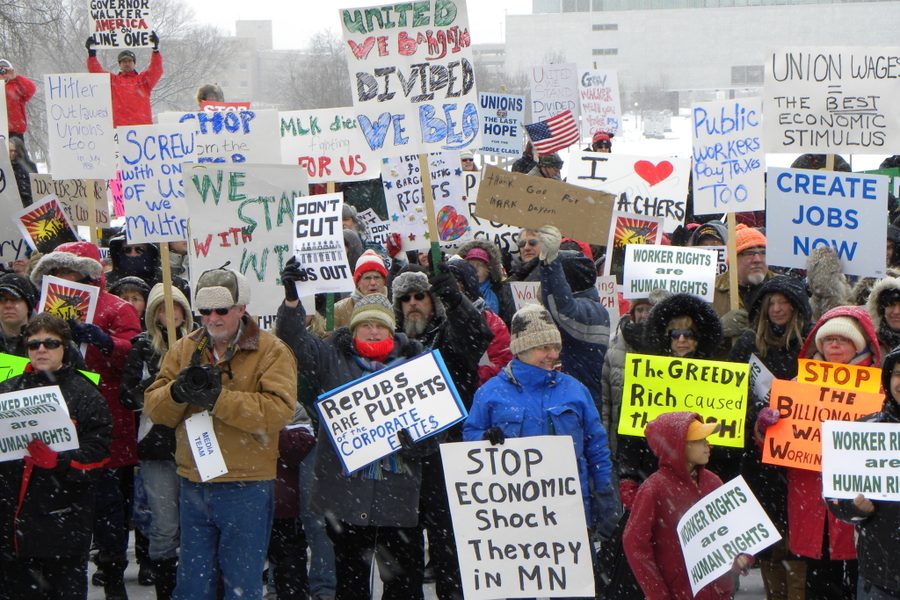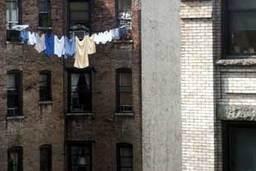
Eighth Avenue south of Madison Square Garden on Sept. 1 blooms with union colors: kelly green for the city workers’ DC 37, gold and navy blue for the electricians’ IBEW Local 3, purple for the janitors’ SEIU Local 32BJ, and red for the academic professors’ Professional Staff Congress union. A band called the Bushwackers — “the pride of Local 802” — plays ‘70s soul tunes, “Fight the Power” and “Ain’t No Stoppin’ Us Now.”
The occasion is New York City’s annual Labor Day parade, moved up to Wednesday for the Republican Convention and converted into an anti-Bush rally. Speaker after speaker assails the president for supporting outsourcing and ending overtime pay for six million workers.
“We’re tired of an administration that has money to build prisons but no money to build schools,” says Bruce Raynor of UNITE/HERE. “The real America is out here in the streets, not with that bunch of thieves in Madison Square Garden.”
Sentiments are similar in the crowd of about 10,000 New Yorkers. “Bush wants Americans to be like Third World people,” says sheet-metal worker Pat Rambert, her Trinidadian accent still strong after 25 years in the United States. “He wants the individual to be at the mercy of the employer.” “He’s not for the middle class at all,” adds Queens electrician Lance Lovejoy, 35.
“Bush is a union-buster. Write that. He’s trying to take away time-and-a-half,” says Michael Chiofalo, president of the Transport Workers Union’s Local 501, which represents workers at the city’s airports. “Bush is using terrorism threats to keep the American public scared, but the economic structure is not there.” Continental Airlines pilots face a generational whipsaw: The young start at $18,000 a year, while the old fear that the airline will emulate United and eliminate their pensions.
“Maybe getting a new president might bring up our salaries,” says Ray Richardson, 53, of Brooklyn, a dreadlocked representative for a DC 37 custodians’ local. “We are underpaid.” He pulls out a pay stub showing an annual salary of $24,752.
Monetary hardships aren’t the only issues people are concerned about.
“I’m tired of people saying No Child Left Behind works,” says Tina Grant, a 10th-grade teacher from Queens. “It doesn’t work here. We need funding.” This is her first demonstration; she carries a placard reading, “Teachers Want a President Who Reads (the Bill of Rights).” There are six people on her block who have been unemployed for a year, she adds.
Joel Herbst, 71, a retired city children’s services worker, compares Bush’s campaign techniques to “the Big Lie” of Joseph Goebbels. Queens nurse Fay Randall simply points to her multiple buttons: “Hands Off Our Overtime Pay,” “Health Care for All,” and “Patients Over Profits.”
Anti-war sentiment is strong too. A muscular, tattooed electrician wears an American flag in the back of his baseball cap and a “Bush Lies, Who Dies?” sticker on his shirt. “If Bush is re-elected, very dangerous for the planet,” says Pedro Vargas, 57, of Queens, a Dominican immigrant who works as a porter by day and a freight-elevator operator by night. Kathy Salak, 55, a nurse-practitioner in Brooklyn, carries a sign reading “Iraq War:
$4-5 Billion Each Month; US: 44 Million With No Health Insurance.” “A lot of our patients are uninsured,” she says. “You give them state-of-the-art surgery and then they can’t take their medications because they can’t afford it.” She’s participated in several other protests this week.
Though this march was by far the most pro-Kerry of the week’s actions, the multiple issues people talked about — along with the feeling that Bush has “hijacked” the country — have been common to all the week’s protests, from the massive August 29 United for Peace and Justice march to the smaller and more radical street actions of August 31 (known to organizers as “A31”). It is possible to speak of a common set of values shared by union members, black and Latino activists, middle-class liberals, feminists, and the younger radicals usually tagged “anarchists.” The people out this week were not single-issue protesters; they usually cited at least four items they were particularly concerned with out of the shared canon of health care, the war, the environment, education, civil liberties, abortion, and the hardships caused by Bush’s plutocratic economic policies.
Yet while their concerns overlapped, the crowds at each event didn’t. Few non-union protesters turned out for the labor rally, and some radicals dismissed it as tame, “people staying in pens and the leaders talking about voting for Kerry.” Meanwhile, the labor contingents formed a relatively small part of the August 29 march, and only a handful of today’s union marchers headed up to Midtown for a protest against corporate media later in the evening. The August 30 demonstrations, both focused on poor people’s issues, also drew disparate demographics: The “Still We Rise” march with a permit was organized by local black, Latino, and Asian community groups and was attended mostly local blacks, Latinos, and Asians, while the “March For Our Lives” without a permit was organized by black Philadelphians and was attended predominantly by young white activists.
In 1999, the World Trade Organization protests in Seattle signified a progressive dream: “Teamsters and turtles,” environmentalists and blue-collar workers uniting in numbers large enough to sit down in the streets and stop access to an oppressive institution — nonviolently. Police cleared the streets with clubs and gas, and the aftermath spawned the stereotype of protesters as rampaging black-clad “anarchists.”
Five years later, the common values are still there — as is the stereotype — but the alliances are not where they should be.
The common enemy is definitely there. The problem is most likely one of organizing contact, communication, and cooperation across different communities. A Kerry victory in November might buy some breathing space against the far-right fanatics of the Bush regime, but these disparate progressive constituencies will have to unite to deal effectively with the war in Iraq, a society where more black men are in prison than in college, and a corporate state that’s trying to asphyxiate working people’s ability to have a decent life.







